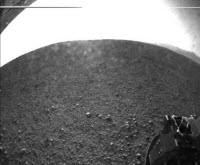Waterloo, CANADA - August 6, 2012 - Teledyne DALSA, a Teledyne Technologies Incorporated (NYSE:TDY) company, is pleased to offer its most sincere congratulations to NASA and JPL on the successful deployment of the Mars Science Laboratory rover "Curiosity" in Gale Crater on Mars. Curiosity is the largest rover ever launched by NASA, and it will be used to determine whether Mars is, or ever has been, hospitable to microbial life.
Teledyne DALSA is proud to contribute to the mission's success. The image sensors for the Curiosity's Navcams and Hazcams were built in our Bromont, Quebec, semiconductor foundry, as were those on the previous Spirit and Opportunity rovers. The hazard avoidance cameras are installed on each corner of the rover and the 3D stereoscopic navigation cameras are part of the rover's camera mast.
 These image sensors represent only a part of Teledyne's overall contributions to the launch, landing, and operation of the mission. No fewer than five Teledyne companies contributed components crucial to the mission's success:
These image sensors represent only a part of Teledyne's overall contributions to the launch, landing, and operation of the mission. No fewer than five Teledyne companies contributed components crucial to the mission's success:
"It gives me great pride to be able to contribute to a project that poses such technical challenges and holds such promise for the advancement of science and knowledge," observed Robert Mehrabian, chairman, president and chief executive officer of Teledyne. "I am also delighted to see how many ways and in how many places Teledyne contributes. From the deepest parts of this planet's oceans to the mountains of Mars and out past the edges of our solar system, Teledyne technology enables exploration, analysis, and communication."
For more on the Mars Science Laboratory and Curiosity, visit http://marsprogram.jpl.nasa.gov/msl/
About Teledyne Technologies
Teledyne Technologies is a leading provider of sophisticated instrumentation, digital imaging products and software, aerospace and defense electronics, and engineered systems. Teledyne Technologies' operations are primarily located in the United States, Canada, the United Kingdom and Mexico. For more information, visit Teledyne Technologies' website at www.teledyne.com.
About Teledyne DALSA
Teledyne DALSA, a Teledyne Technologies company, is an international leader in high performance digital imaging and semiconductors with approximately 1,000 employees worldwide, headquartered in Waterloo, Ontario, Canada. Established in 1980, the company designs, develops, manufactures and markets digital imaging products and solutions, in addition to providing specialized semiconductor products and services including MEMS. For more information, visit Teledyne DALSA's website at www.teledynedalsa.com.

This image from one of Curiosity's Hazard-Avoidance cameras was taken August 6 with an image sensor built in Teledyne DALSA's Bromont semiconductor foundry. Image credit: NASA/JPL-Caltech